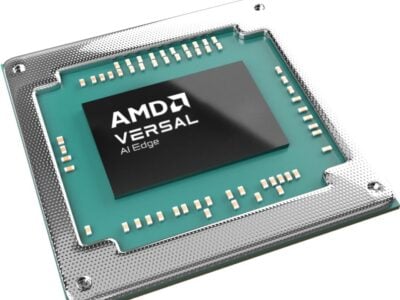
imec spinout Swave raises €7m for 3D display
Swave Photonics in Leuven has emerged from stealth mode raised €7m ($7m) to commercialise a 3D real time holographic display engine.
The company is a spin out of Belgian research lab imec and the Vrije Universiteit Brussel (VUB). The company is industrialising a pixel technology developed at imec. These pixels are half the wavelength of light at 220nm and digitally controlled to diffract the light or not. This provides interference pattern for a 3D display. The company is developing a 20 x 20mm chip with a gigapixel array with a frame rate of 60fps.
The chip will be built in a 20nm process technology that is “90% standard CMOS,” says Theodore Marescaux, CEO of Swave
“You have the Turing test where you cannot distinguish an AI form a real person. We have a visual Turing test, where you not able to distinguish a projected image from reality,” he tells eeNews Europe.
“The system we are bringing is sending all of the image with all the possible focus points so you can read a book in VR or see all the leaves on a tree in detail, and the systems today don’t show that.”
“We are making lightwaves interfere and to do that we have a tiny pixel, or diffractor, technology that imec developed,” he said “That pixel needs to be very small, half the wavelength of the light so for 450nm blue our pixel is smaller than 220nm. This means it can be a good diffractor of light and have a very high density of pixels so we are in the gigapixel array.”
- 8K holographic display makes debut
- Two team for holographic automotive displays
- VividQ raises £11m for holographic displays
“We change the optical properties of the pixel by programming it with a 1 or 0, and we put a 2D generated hologram on it and light up by three lasers, RGB, to create a 3D image,” he explained.
One key application is of course the metaverse, using two arrays in a headset for a high quality immersive display.
Another predicted use he calls the holographic wall. This would consist of a number of boxes, where each box has a projector to create any shape of screen. “I would expect the initial boxes to be 10 x 10cm or 15 x 15cm and you can stack as many as you want,” he said.
With a gigapixel array the addressing of the memory under each pixel is key to get the required high frame rate. This is a key part of the chip design funded by the seed round, and will use multiple serial/deserialiser (serdes) connections, says Marescaux.
“The data rate is challenging but this is done is existing systems,” he said. “The challenge is in the computation of the holograms and we have some good ideas of how to do that.”
That is the issue being addressed bby another European startup, Imverse in Switzerland, to reduce the data rate required for 3D imaging.
- Imverse raises $4.8m for live holograms on Zoom
- MicroLED architecture prepares for holographic displays
“For the chip itself we will have samples by the end of 2023 for devices in 2024 so it gives us time to work with partners on the computer side,” said Marescaux at Swave. “The test chip will have multiple arrays of multiple sizes,” he said. This will allow the initial chip to be used for different applications.
The design does not need large amounts to redundancy to get an acceptable yield, which will make the device cost effective for metaverse platforms, 360-degree holographic walls, 3D gaming, AR/VR/XR glasses, collaborative video conferencing, and heads-up displays for automotive and aerospace systems.
“One of the nice things about holography is its pretty robust to defects, unlike a memory product,” he said. “Here if you have a few percent of pixels fail it still works fine. If you are looking at systems such as Hololens we should have no problem being in the same range [of cost].”
The backers include imec.xpand and Flanders Future Techfund (FFTF) as well as QBIC, a Belgian inter-university venture capital fund is also participating.
“We are convinced that Swave can bring to the market a fundamental technology we have been developing for more than five years through substantial R&D programs and imec investments,” said Luc Van den hove, president and CEO of imec. “Imec has a strong track record of innovation and productization that can scale across a wide range of applications.
“We are committed to make Swave a success and have great confidence that with their extensive patent portfolio and continued support of our teams and ecosystem, Swave can become one of the biggest disruptors for immersive 3D displays and a key accelerator for applications like the metaverse,” he said.
“As a co-lead investor in this seed round, investing from our brand-new xpand-II fund, we are helping to build and grow a disruptive, deep-tech holographic company,” said Peter Vanbekbergen, a partner at imec.xpand.
“We are convinced that Swave’s transformative gigapixel holographic technology can fuel the $93 billion AR/VR, metaverse market and will position Swave to enable an upgrade to today’s challenging AR/VR immersive experiences.”
Related holographic display articles
- Researchers improve holographic printing material, resolution
- SDK for consumer holographic light field camera
- Car cockpit uses lightfield technology for 3D display
Other articles on eeNews Europe
- Foundries.io looks to $1bn IPO
- World’s first native plastic programmable processor
- Opteran raises $12m for neuromorphic AI
- World’s first 1.5TB industrial microSD card
- congatec enters functional safety market
 If you enjoyed this article, you will like the following ones: don't miss them by subscribing to :
eeNews on Google News
If you enjoyed this article, you will like the following ones: don't miss them by subscribing to :
eeNews on Google News


